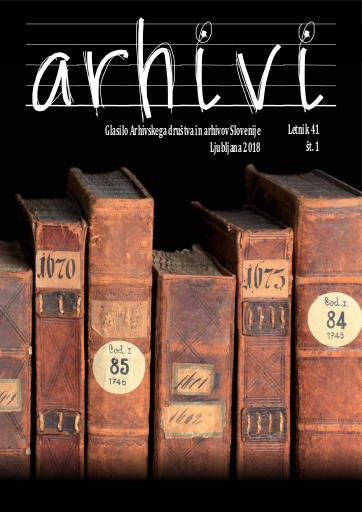/
Serijske publikacije
/
Arhivi
Starejše arhivsko gradivo o zdravstvu, hranjeno v Pokrajinskem arhivu Koper, s poudarkom na delovanju ubožnih ustanov od 13. do začetka 20. stoletja


To delo avtorja Zdenka Bonin je ponujeno pod Creative Commons Priznanje avtorstva-Nekomercialno-Deljenje pod enakimi pogoji 4.0 Mednarodna
Datoteke (1)

Opis
Organizirano skrb za zdravstveno stanje ljudi je v Kopru mogoče spremljati vsaj od 13. stoletja dalje. Na vhodu v mesto je bil že leta 1262 postavljen špital sv. Nazarija, v katerem so našli zavetje romarji, mestni reveži, pohabljeni, od rojstva prizadeti posamezniki, najdenčki in oboleli, v 14. stoletju pa je Marco Trivisano v Zubenagi uredil še zavetišče za siromašne ženske. Mesto je imelo zdravnika in kirurga; oba sta morala biti vsako leto potrjena v velikem svetu. Za obubožane prebivalce mesta so skrbeli tudi laične bratovščine in redovniki, zlasti serviti. Francozi so namesto ukinjenih bratovščin, ki so do tedaj skrbele za ubožne ustanove, ustanovili dobrodelno kongregacijo. Mestni špital so leta 1810 preselili v poslopje opuščenega servitskega samostana. Okrajni zdravnik Giovanni Andrea de Manzoni je sredi 19. stoletja pripravil pravilnik mestne bolnišnice. Poleg revežev iz celotnega koprskega zaledja je sprejemala tudi bolnike. Za revne otroke od 3 do 6 let starosti je bil v Kopru leta 1839 ustanovljen dobrodelni vrtec, leta 1859 pa še dobrodelna ustanova Grisoni, ki je skrbela za vzgojo in izobraževanje otrok med 6. in 20. letom starosti.
Metapodatki (12)
- identifikatorhttps://hdl.handle.net/11686/41582
- naslov
- Starejše arhivsko gradivo o zdravstvu, hranjeno v Pokrajinskem arhivu Koper, s poudarkom na delovanju ubožnih ustanov od 13. do začetka 20. stoletja
- Older Archival Records on Health Care Services Kept in Regional Archives Koper with the Emphasis on the Operation of Poorhouses from the 13th to the Early 20th Century
- avtor
- Zdenka Bonin
- soavtor
- Gregor Jenuš (gl. in odg. ur.)
- Marija Grabnar (ur.)
- Dunja Mušič (teh. ur.)
- Petra Markuš (prev.)
- Marija Grabnar, Andreja Klasinc Škofljanec in Borut Jurca (foto.)
- predmet
- ČLANKI IN RAZPRAVE
- Koper
- zdravstvena oskrba
- zdravstveni uradi
- špitali
- najdenčki
- mestna bolnišnica
- vrtec
- sirotišnica
- ARTICLES AND PAPERS
- Koper
- health care
- health offices
- hospitals
- town hospital
- nursery
- orphanage
- opis
- Preventive health care was of great importance to the Republic of Venice. The town had the best doctors from recognised universities (e.g. Padua). Due to diversified commercial contacts with Middle East countries and North African countries where plague epidemics were often breaking out, Venetians started building lazarets (the 1st one was built on the island in Venetian lagoon in 1423) and other warehouses where goods were stored for a certain period. They also established special judiciaries of health office (Provveditori alla Sanità as permanent office was established in 1485) responsible for preventive health care of townspeople. Health care supervisors carefully monitored the situation across the Mediterranean as well as in the Venetian hinterland. Upon the occurrence of plague or any other infectious disease, swift action and necessary measures to protect the population were taken. Ships and merchants were diligently examined, especially those that came from areas where the infectious disease was spreading. The period of quarantine was extended to 40 days and they took measures to ensure nobody was allowed to transport cargo to or from the port without a health card. The Senate also established health offices in provinces. Thus, on 27. 2. 1576, Health office (Procuratori della Sanità; composed of 3 officials) was established in Piran; on 25. 3. 1577 the head office health care for the province (Sede di Sanità) was established in Koper. Officials supervised arrivals and departures of ships in city‘s ports and berths on private piers. Upon breakout of an infectious disease, they took different measures to prevent the spread of the disease (e. g. strict control; in front of the town a galley was anchored which at the same time served as a trade exchange and quarantine. Istrian towns have a long tradition of organized health care. Following the example of Venice, hospitals were organized in the cities already in the 13th century. Piran hospital was established at the end of 1222, the one in Koper in 1262, and the establishment of hospital in Izola can probably be traced to the 13th century. Koper commune established St. Nazarius hospital at the town entrance, in which pilgrims, the poor, the lamed, the handicapped since birth, foundlings, and the sick found shelter. Townspeople donated bread, wine, and oil to the hospital in order to support 10 poor persons, as well as other income of 13 lire. Hospital administration consisted of two procurators, who had to be elected every year in the Great Town Council, and prior who received 6 pounds a year. Maid took care of the sick and the poor, while priest performed Mass in the hospital every day. Since the financial situation of the hospital deteriorated, in 1454 the commune authorities entrusted the management to the most prominent Brotherhood of St. Anthony the Abbot in Koper. Upon the visitation of bishop Agostino Valier of Verona in 1580, the hospital had income of 2000 lire. The hospital admitted the poor of both genders, foreigners, patients, and foundlings. They were kept in the hospital until their numbers swelled to the point when they were sent with a nurse to Venetian orphanage. The hospital building was well maintained. The below room with beds without bedding was empty, while the upper part had six rooms, five of which were furnished with mattresses, sheets, and blankets. The sick were treated by the commune doctor and surgeon. In Zubenaga district in the other part of the town, Marco Trivisano founded the hospital of St. Mark for women in the 14th century. In 1580, the facility included church dedicated to St. Mark the Evangelist, and a narrow courtyard with modest cells along the sides. At that time, the hospital had 830 lire in its treasury; at the founder‘s request, it received 126 lire every year. However, these were its only source of income. Although eight poor women should be supported by the hospital, there were only six at that time. Even later, the financial situation of the hospital did not improve, and around 1700, women were offered only overnight accommodation, whereas food was also provided in the past. The first known doctor to date in Koper was ser Benvenuto who worked as a doctor in Koper in 1310. The 1423 statute governed commune doctor‘s remuneration; he received 3 pounds of small notes every time he left town in the event of an offence. The doctor and surgeon, who had to notify podesta of any violent injury as well as of ordinary injuries they had treated, had to be approved at least from 1452 onwards every year 3 months prior to the end of their service by a large majority in the Great Town Council. In 1602, the Venetian doge Nicolo Grimani raised the doctor‘s salary from 120 to 200 ducati, while the Great Town Council of Koper decided at the meeting in 1661 that medical service in the town could be performed only by foreigners. Santori Santori should be noted as one of the numerous important doctors of Koper who is regarded as the great medical researcher and writer of the 16th century. In addition to praying to Mary and the deceased, the friars of the Servite monastery, who settled in the city in 1454, performed Mass and preached, however, special attention was paid to the spiritual care of pilgrims, the poor, and the sick. Since there were few friars in the monastery, it was abolished at the end on the 18th century. After conquering the city, the Austrians set up a military hospital in the empty building of the Servite monastery in 1801, and the church became a temporary prison for criminals. When Istria came under the French rule and numerous brotherhoods, which had managed poorhouses until then were abolished, charity congregations were founded in cities. Congregation in Koper had to focus primarily on taking care of foundlings while it also cared for the poor and mentally ill in Koper. The St. Nazarius hospital with the orphanage was moved to the former monastery in 1810, whereas the church was converted into a warehouse in 1850. Because of the abolition of the annual contribution of seven Istrian municipalities for the orphanage of Koper in 1813 and outstanding debts from the period of French rule, the hospital got into financial difficulties which were resolved only in the mid-19th century after acquiring the income of the abolished Brotherhood of St. Anthony Abbot and when it was granted the national status of a shelter for the poor and treatment of patients. The hospital was renamed to town hospital. Regulations for the town hospital were written by Dr Giovanni Andrea de Manzoni who was the municipal representative and district physician. The hospital was managed by directorate while the municipality financed two doctors with a degree in medicine and surgery and with the knowledge of obstetrics from the public purse. They received 600 florins per year for their work. They were obligated to treat the town poor, along with patients and care recipients of the town hospital free of charge. The town also paid two midwives, one in the town, and the other for tax municipality of Lazaret in order for them to help poor birthing mothers free of charge. In 1980s, the city had two pharmacies. As insinuations of irregularities in the hospital were spreading through the town, the merchants who supplied it with meat and bread stated more than 2000 florins of unpaid bills, the municipal representation urged the directorate to prepare a detailed balance. In view of the above-mentioned difficulties, imperial-royal interim leadership in Trieste invited the sisters of the Third Order of St. Francis to the town in 1886. Until 1915, the sisters of the Third Order of St. Francis were responsible for managing hospitals, caring for patients and helping the poor. Since they were Italian citizens, they had to leave the city after Italy entered the war despite exemplary care for patients. In the mid-19th century, a charity nursery school for children (between the ages of 3 and 6) and Grisoni charity institution (for children from 6 to 20 years old) were established in the town where children acquired qualifications, while girls received dowry (at first, 105 florins, and later 210 florins) upon leaving. The evolution of society is reflected in its attitude towards people who are in need the most, and foundlings and orphans most certainly belong among them. The more the society is sophisticated and educated the more sensitive it is to the problems of other people and tries to face such difficulties and overcome them. Wealthy individuals and various secular institutions were the first to offer help with the care of helpless children and youth. From the beginning of the 19th century and onwards however, public authority in the spirit of Enlightenment also became involved in resolving these problems, namely through its legislation, establishment of foundling institutions, organizing foster care, opening nursery schools, and including children in schools. Although far from modern social politics, the foundations for more equal treatment of the most deprived population group were laid.
- založnik
- Arhivsko društvo Slovenije
- datum
- 2018
- 01. 01. 2018
- tip
- besedilo
- jezik
- Slovenščina
- jeDelOd
- pravice
- licenca: ccByNcSa
